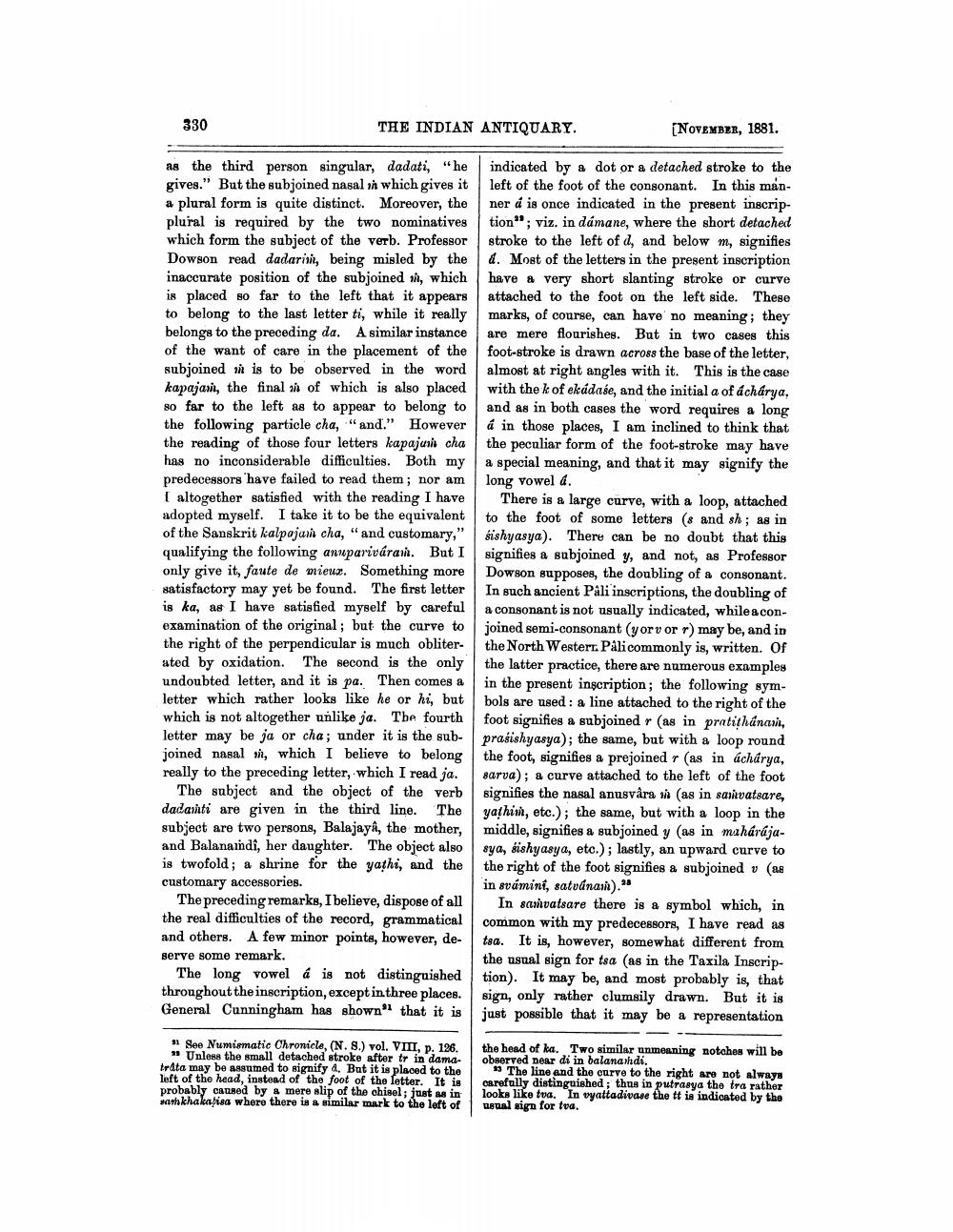________________
330
THE INDIAN ANTIQUARY.
(NOVEMBER, 1881.
as the third person singular, dadati, "he indicated by a dot or a detached stroke to the gives." But the subjoined nasal which gives it left of the foot of the consonant. In this mana plural form is quite distinct. Moreover, the ner á is once indicated in the present inscripplural is required by the two nominatives tion"; viz. in dámane, where the short detached which form the subject of the verb. Professor stroke to the left of d, and below m, signifies Dowson read dadari, being misled by the d. Most of the letters in the present inscription inaccurate position of the subjoined 1, which have a very short slanting stroke or curve is placed so far to the left that it appears attached to the foot on the left side. These to belong to the last letter ti, while it really marks, of course, can have no meaning; they belongs to the preceding da. A similar instance are mere flourishes. But in two cases this of the want of care in the placement of the foot-stroke is drawn across the base of the letter, subjoined it is to be observed in the word almost at right angles with it. This is the case kapajasi, the final i of which is also placed with the k of ekádase, and the initial a of acharya, so far to the left as to appear to belong to and as in both cases the word requires a long the following particle cha, "and." However á in those places, I am inclined to think that the reading of those four letters kapajui cha the peculiar form of the foot-stroke may have has no inconsiderable difficulties. Both my | a special meaning, and that it may signify the predecessors have failed to read them; nor am long vowel d. I altogether satisfied with the reading I have There is a large curve, with a loop, attached adopted myself. I take it to be the equivalent to the foot of some letters (8 and sh; as in of the Sanskrit kalpojani cha, "and customary," sishyasya). There can be no doubt that this qualifying the following anuparivarash. But I signifies a subjoined y, and not, as Professor only give it, faute de mieux. Something more Dowson supposes, the doubling of a consonant. satisfactory may yet be found. The first letter In such ancient Páli inscriptions, the doubling of is ka, as I have satisfied myself by careful a consonant is not usually indicated, whileaconexamination of the original; but the curve to | joined semi-consonant (yor v or r) may be, and in the right of the perpendicular is much obliter- the North Westerr. Palicommonly is, written. Of ated by oxidation. The second is the only the latter practice, there are numerous examples undoubted letter, and it is pa. Then comes a in the present inscription; the following symletter which rather looks like he or hi, but bols are used: a line attached to the right of the which is not altogether unlike ja. The fourth foot signifies a subjoined r (as in pratithanar, letter may be ja or cha; under it is the sub
prasishyasya); the same, but with a loop round joined nasal i, which I believe to belong the foot, signifies a prejoined r (as in acharya, really to the preceding letter, which I read ja. sarva); a curve attached to the left of the foot
The subject and the object of the verb signifies the nasal anusvåra s (as in saivatsare, dadanti are given in the third line. The yathini, etc.); the same, but with a loop in the subject are two persons, Balajaya, the mother, middle, signifies a subjoined y (as in mahárájaand Balanandi, her daughter. The object also sya, sishyasya, etc.); lastly, an upward curve to is twofold; a shrine for the yathi, and the the right of the foot signifies a subjoined v (as customary accessories.
in svámini, satvánar). The preceding remarks, I believe, dispose of all In samvatsare there is a symbol which, in the real difficulties of the record, grammatical common with my predecessors, I have read as and others. A few minor points, however, de- tsa. It is, however, somewhat different from serve some remark.
the usual sign for tsa (as in the Taxila InscripThe long vowel á is not distinguished tion). It may be, and most probably is, that throughout the inscription, except in three places. sign, only rather clumsily drawn. But it is General Cunningham has shown that it is just possible that it may be a representation
11 See Numismatic Chronicle, (N. S.) vol. VIII, p. 126.
Unless the small detached stroke after tv in damatrata may be assumed to signify 4. But it is placed to the left of the head, instead of the foot of the letter. It is probably caused by a mere slip of the chisel: just min sankhakafisa whoro there is a similar mark to the left of
the head of ka. Two similar unmeaning notches will be observed near di in balanashdi.
* The line and the curve to the right are not always carefully distinguished; thus in putrasya the tra rather
looks like tva. In vyattadivase the tt is indicated by the 1 neual sign for tva.




